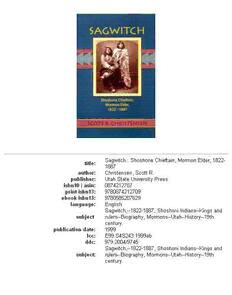
Sagwitch: Shoshone chieftain, Mormon elder, 1822-1887 PDF
01999·1.868 MB·English
Most books are stored in the elastic cloud where traffic is expensive. For this reason, we have a limit on daily download.
Preview Sagwitch: Shoshone chieftain, Mormon elder, 1822-1887
Description:
"The Northwestern Shoshone knew as home the northern Great Salt Lake Valley, Bear River, Cache Valley, and Bear Lake - northern Utah. Sagwitch was born in this core fur trapping region at a time when his people had close associations with the mountain men. Sagwitch came to manhood and a leadership position as wagon trains began crossing his people's territory. Wagons later brought Mormon settlers, who by the late 1850s were occupying Cache Valley, the Northwestern Shoshone heartland. Emigrants and settlers reduced Shoshone access to traditional village sites and food resources. It only took a few violent incidents for a gung-ho army colonel to seek severe punishment of the Northwestern Shoshone on an early winter morning in 1863. The Bear River Massacre was among the most bloody engagements of America's Indian wars. Hundreds of Shoshone, including Sagwitch's wife and two stepsons, died; he was wounded but escaped."--BOOK JACKET. "The following years were very hard for the survivors. The federal government negotiated a treaty with them but failed to get Sagwitch's signature when, enroute to the meeting, he was arrested and then wounded by a white assassin. With the world around him changed, Sagwitch sought accommodation with the most immediate threat to his people's traditional way of survival - the Mormons occupying Shoshone homelands. This, then, is also the story of the conversion of Sagwitch and his band to the Mormon Church. Though not without conflicts and problems, that conversion was long lasting and thorough. Sagwitch and other Northwestern Shoshone would demonstrate in important ways their new religious devotion."--BOOK JACKET.
See more
The list of books you might like
Most books are stored in the elastic cloud where traffic is expensive. For this reason, we have a limit on daily download.
